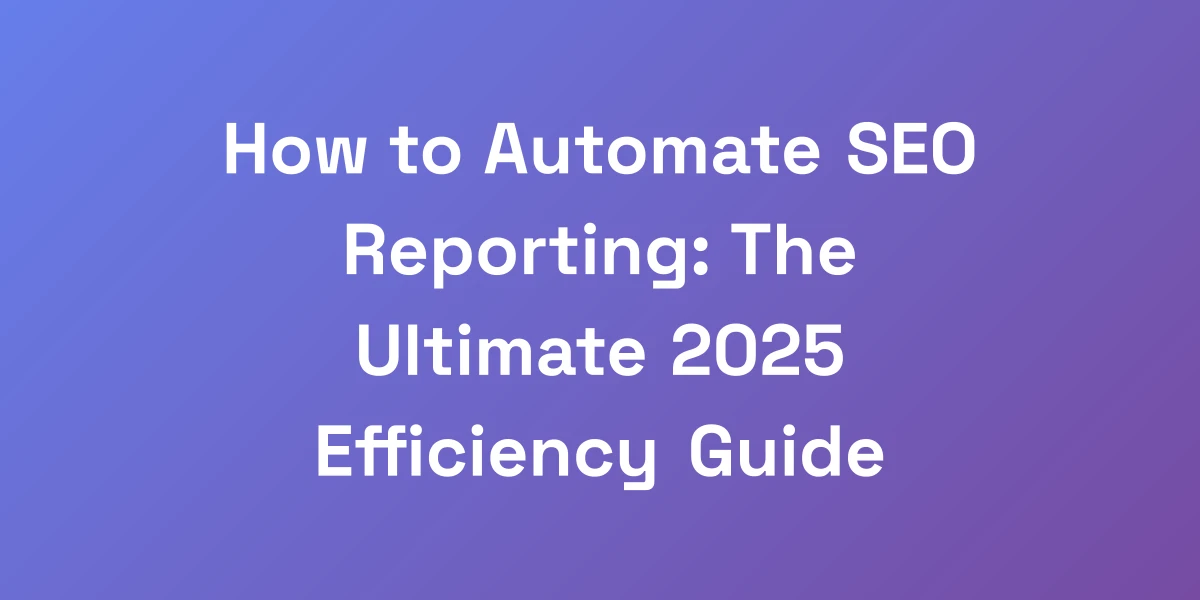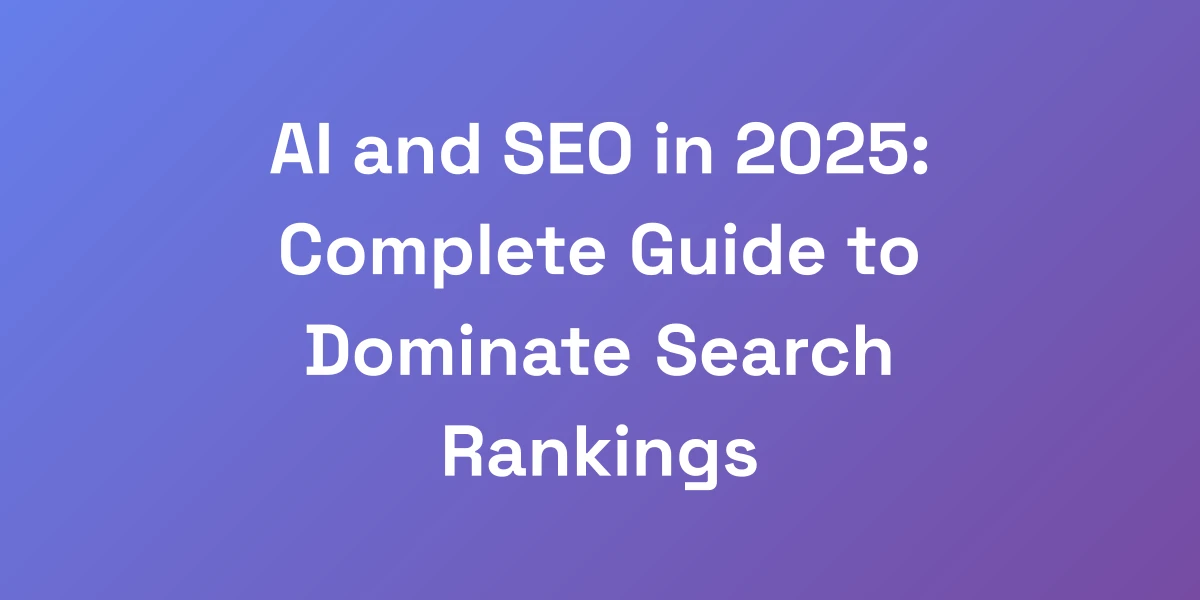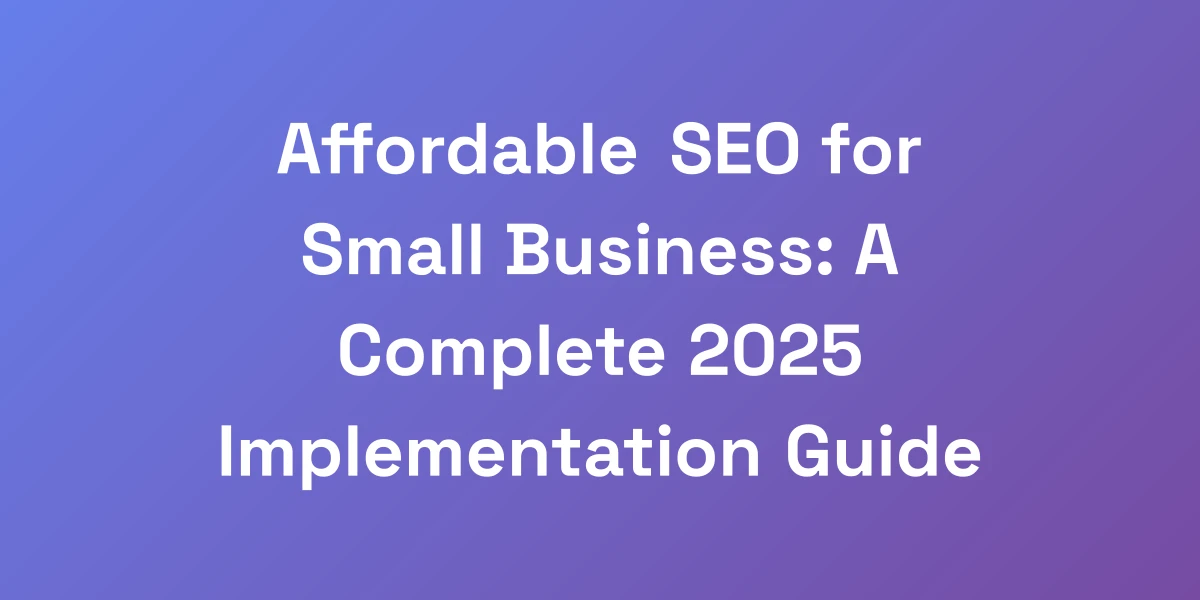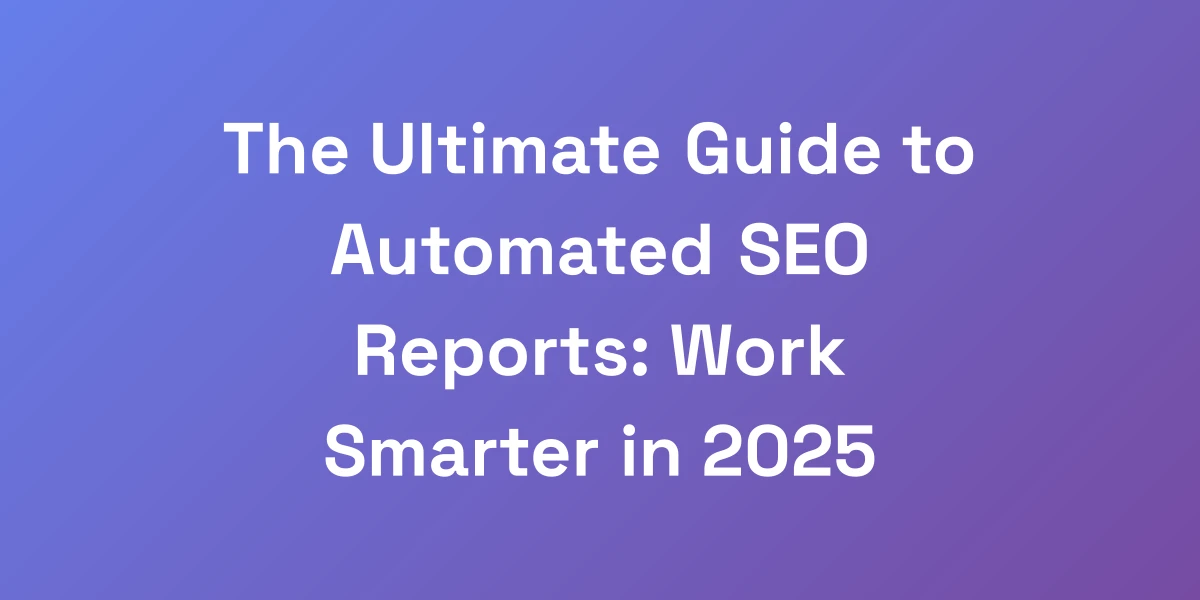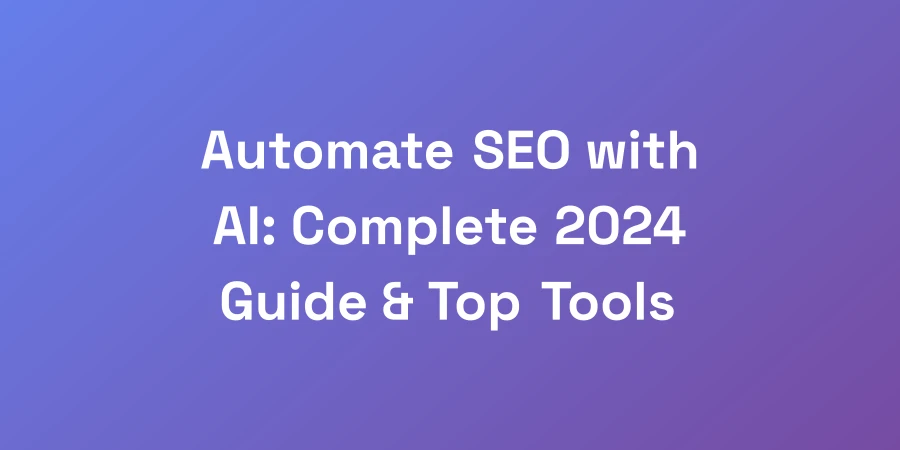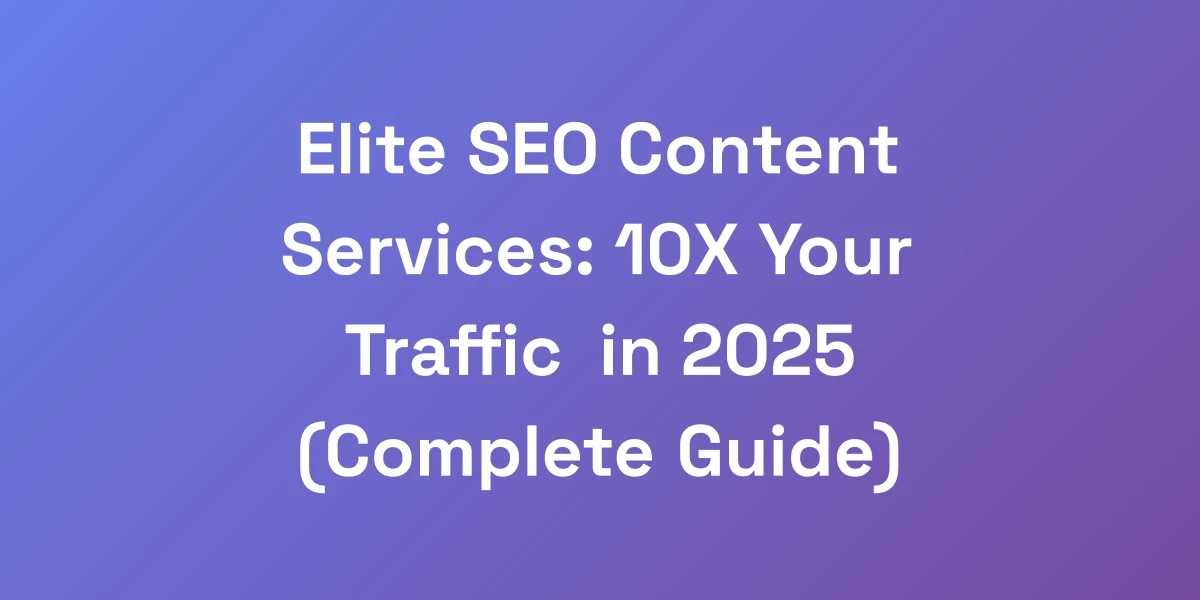
How to Automate SEO: A Complete Guide to Working Smarter in 2025
Feb 24, 2025 | By [email protected]
How to Automate SEO: A Complete Guide to Working Smarter in 2025
Ever felt like you’re spinning your wheels trying to keep up with the relentless pace of SEO? You’re not alone.
In the ever-evolving world of search engine optimization, staying afloat requires more than just hard work—it demands smart strategies.
Imagine having a team that works around the clock, handling the mundane tasks so you can focus on what truly matters: growth and innovation.
That’s the promise of SEO automation. It’s not just a trend; it’s becoming a cornerstone for those serious about scaling their rankings efficiently.
But how exactly does automation transform your SEO efforts? And what should you consider before diving in?
Let’s explore the intricacies of automating SEO in 2025, addressing the challenges and unveiling the possibilities that lie ahead.
Understanding SEO Automation: The Smart Way to Scale Your Rankings
In today’s fast-paced digital landscape, manual SEO is becoming increasingly unsustainable. As someone who’s spent countless hours optimizing websites, I’ve learned that automation isn’t just a luxury—it’s a necessity.
SEO automation combines artificial intelligence, machine learning, and smart tools to handle repetitive tasks while maintaining quality. Think of it as having a virtual SEO team working 24/7, allowing you to focus on strategy and creative decisions that truly move the needle.
What Makes SEO Automation Different in 2025
The SEO landscape in 2025 is vastly different from previous years, thanks to advancements in AI and machine learning.
SEO automation tools are now more intelligent, capable of understanding context, predicting trends, and adapting to algorithm changes with minimal human intervention.
Unlike traditional tools that require manual input and frequent adjustments, automated solutions offer a dynamic approach, learning from data to optimize continuously.
For example, AI-powered keyword research tools don’t just provide a list of keywords; they analyze user intent and predict future search patterns, ensuring your content stays relevant and ahead of the competition.
The Evolution from Manual to Automated SEO
SEO has always been a blend of art and science, requiring both creative and analytical skills.
Initially, SEO efforts were largely manual—keyword research, link building, and content optimization were painstakingly done by hand.
However, as the internet expanded and competition intensified, the limitations of manual SEO became apparent.
Enter automation: tools that can perform extensive tasks in a fraction of the time, with greater accuracy and consistency.
Today, automation doesn’t just replicate manual tasks; it enhances them, providing deeper insights and more effective strategies.
Consider how automated technical audits can continuously monitor your website for issues, ensuring optimal performance without constant manual checks.
Key Benefits of Implementing SEO Automation
The benefits of automating your SEO efforts extend beyond mere time savings.
- Efficiency: Automation handles repetitive tasks swiftly, allowing you to allocate time to more strategic initiatives.
- Consistency: Automated processes ensure that SEO practices are applied uniformly across your website, reducing the risk of human error.
- Scalability: As your business grows, automation allows you to manage larger volumes of work without a proportional increase in resources.
- Data-Driven Decisions: Comprehensive analytics provided by automation tools enable informed decision-making based on accurate data.
- Enhanced Competitiveness: With automation, you can stay ahead of SEO trends and algorithm changes, maintaining a competitive edge.
For instance, SEO strategies tailored for financial services exemplify how automation can address industry-specific challenges effectively.
Common Misconceptions About Automated SEO
Despite its advantages, SEO automation is often misunderstood.
One prevalent misconception is that automation can replace human expertise entirely. In reality, automation is designed to complement human skills, handling repetitive tasks so professionals can focus on strategic planning.
Another myth is that automation is only for large enterprises. On the contrary, businesses of all sizes can benefit from automation, enhancing efficiency and effectiveness regardless of scale.
Additionally, some believe that automated tools produce low-quality results. However, with advancements in AI, automation now delivers high-precision outcomes that adhere to best SEO practices.
It’s crucial to understand that automation is a tool in your SEO arsenal, not a standalone solution.
Areas Where Automation Excels vs. Human Touch
Automation shines in areas that require speed, consistency, and handling large volumes of data.
- Technical Audits: Automated tools can continuously scan your website for technical issues, ensuring optimal performance without constant manual checks.
- Keyword Research: AI-driven tools can analyze vast datasets to identify high-potential keywords faster and more accurately than manual methods.
- Performance Tracking: Automation provides real-time analytics, allowing for swift adjustments to strategies based on performance data.
On the other hand, tasks that require human creativity and strategic thinking still benefit from a personal touch.
- Content Creation: While AI can generate content drafts, human input ensures the content is engaging, authentic, and aligned with brand voice.
- Strategic Planning: Developing comprehensive SEO strategies that align with business goals requires human insight and creativity.
- Relationship Building: Effective link building often involves personal outreach and relationship management, areas where human skills are irreplaceable.
By leveraging automation for the heavy lifting and applying human expertise where it matters most, you create a balanced and effective SEO strategy.
For small businesses, integrating content marketing strategies can further enhance this process.
Essential SEO Tasks You Should Automate Today
After years of experimenting with various SEO workflows, I’ve identified the key areas where automation delivers the most impact. The beauty of automating these tasks isn’t just about saving time—it’s about maintaining consistency and scaling your efforts effectively.
From technical audits to content optimization, these automation opportunities can transform your SEO strategy from good to exceptional, while freeing up valuable hours for strategic thinking and creative problem-solving.
Technical SEO Audits and Monitoring
Technical SEO is the backbone of any successful SEO strategy. Automated tools can continuously monitor your website for issues like broken links, slow page speed, and mobile usability problems.
- Consistency: Regular automated audits ensure that potential issues are identified and resolved promptly.
- Comprehensive Coverage: Automation tools cover all aspects of technical SEO, from site structure to crawl errors, providing a holistic view of your website’s health.
- Real-Time Alerts: Receive instant notifications when critical issues arise, allowing for swift action.
For example, tools like Ahrefs and SEMrush offer robust technical audit features that can scan your website regularly, providing detailed reports and actionable insights.
Actionable Tip: Schedule automated technical audits weekly to stay ahead of potential issues and maintain optimal site performance.
Keyword Research and Clustering
Keyword research is fundamental to SEO, but manually sifting through data can be time-consuming and inefficient.
- Efficiency: AI-driven tools can analyze vast amounts of data quickly, uncovering high-potential keywords that might be overlooked manually.
- Clustering: Automation tools can group related keywords, helping you create more organized and targeted content strategies.
- User Intent Analysis: Modern tools don’t just identify keywords—they analyze user intent, ensuring your content aligns with what your audience is searching for.
For instance, Chatsonic’s SEO AI Agent can automate keyword research, providing strategic insights into keyword opportunities that drive meaningful traffic.
Actionable Tip: Use keyword clustering tools like SEMrush to organize keywords into themes, streamlining your content planning process.
Content Brief Generation
Creating comprehensive content briefs is essential for producing high-quality, SEO-friendly content. However, manually generating these briefs for each piece of content can be tedious.
- Speed: Automated tools can generate detailed content briefs in minutes, outlining key topics, keywords, and structure.
- Consistency: Ensure that every piece of content adheres to SEO best practices and brand guidelines.
- Customization: Tailor content briefs to different content types, such as blogs, landing pages, or product descriptions.
Tools like SEO.ai and Outranking can generate optimized content briefs, saving time and enhancing content quality.
Actionable Tip: Implement automated content brief generators to streamline your content creation process and maintain consistency across all your content.
Performance Tracking and Reporting
Tracking the performance of your SEO efforts is crucial for understanding what works and what doesn’t. Automated performance tracking tools can provide real-time insights into key metrics.
- Real-Time Data: Access up-to-date information on rankings, traffic, and conversions without manual data entry.
- Comprehensive Reports: Automated reports offer a detailed analysis of your SEO performance, highlighting areas for improvement.
- Custom Dashboards: Create personalized dashboards that focus on the metrics that matter most to your business.
Platforms like Google Analytics and Data Studio allow for automated reporting, enabling you to monitor your SEO performance effortlessly.
Actionable Tip: Set up automated performance dashboards to continuously monitor your SEO metrics and make data-driven decisions.
Competitor Analysis and Tracking
Understanding your competitors is key to staying ahead in SEO. Automated competitor analysis tools can provide deep insights into your rivals’ strategies.
- Comprehensive Insights: Analyze competitors’ keywords, backlinks, and content strategies to identify opportunities and threats.
- Benchmarking: Compare your SEO performance against competitors to gauge your standing in the market.
- Opportunity Identification: Discover gaps in your competitors’ strategies that you can exploit to gain an edge.
Tools like Ahrefs and Search Atlas offer robust competitor analysis features, providing actionable insights that can inform your SEO strategy.
Actionable Tip: Regularly review competitor analysis reports to stay informed about industry trends and adjust your strategies accordingly.
Internal Linking Optimization
Internal linking is a critical aspect of SEO, enhancing site navigation and distributing link equity across your website. However, manually managing internal links can be labor-intensive.
- Efficiency: Automation tools can identify linking opportunities and suggest optimal anchor text and placement.
- Consistency: Ensure that internal links are consistently applied across all pages, improving overall site structure.
- SEO Benefits: Proper internal linking enhances your site’s SEO by improving crawlability and user experience.
Solutions like Link Whisper and Yoast SEO automate internal linking suggestions, making it easier to maintain a well-structured website.
For businesses focusing on local SEO, integrating local business directories can significantly boost your local search visibility.
Actionable Tip: Utilize internal linking automation tools to regularly optimize your site’s internal links, enhancing both SEO and user experience.
Top AI-Powered SEO Automation Tools Worth Your Investment
Having tested dozens of SEO tools, I can confidently say that not all automation solutions are created equal. The best tools combine powerful functionality with user-friendly interfaces and reliable results.
In this section, I’ll share my personal experiences with the most effective SEO automation tools that have consistently delivered results for my projects and those of my clients.
These aren’t just random recommendations—they’re battle-tested solutions that actually work.
For digital marketing agencies aiming for 7-figure growth, adopting frameworks from proven agency growth strategies can complement your SEO automation tools effectively.
Content Optimization Tools
Content is king, but optimizing it for search engines is crucial.
- SEMrush: Offers comprehensive content analysis, suggesting improvements in keyword usage, readability, and structure.
- Surfer SEO: Analyzes top-ranking pages and provides data-driven recommendations to enhance your content’s SEO performance.
- INK: Combines AI and SEO insights to help you create optimized content that ranks higher and engages readers.
Actionable Tip: Integrate content optimization tools into your workflow to ensure every piece of content is primed for maximum SEO impact.
Technical SEO Automation Platforms
Technical SEO is essential for website performance and search engine rankings. Automated platforms streamline these processes, ensuring your site remains in top shape.
- Ahrefs: Conducts comprehensive site audits, identifying technical issues and providing actionable insights to rectify them.
- SEMrush: Offers robust technical SEO tools that monitor site health, crawl errors, and page speed, ensuring optimal performance.
- Search Atlas: Specializes in large-scale technical SEO tasks, making it ideal for enterprise-level websites.
Actionable Tip: Regularly schedule automated technical audits to maintain your website’s health and address issues before they impact your rankings.
Reporting and Analytics Automation
Understanding your SEO performance is crucial for making informed decisions. Automated reporting tools can simplify this process, providing detailed insights without the manual effort.
- Google Data Studio: Allows you to create custom dashboards that integrate data from multiple sources, providing a comprehensive view of your SEO performance.
- Tableau: Offers advanced data visualization capabilities, enabling you to uncover deeper insights from your SEO data.
- SEMrush: Provides automated reporting features that compile essential SEO metrics into easy-to-understand reports.
Actionable Tip: Utilize automated reporting tools to create real-time dashboards that track your key SEO metrics, facilitating timely adjustments to your strategies.
AI-Powered Writing Assistants
Creating high-quality content consistently can be challenging. AI-powered writing assistants can help streamline this process, ensuring your content is both engaging and optimized for SEO.
- Jasper: Generates content drafts based on your input, allowing you to quickly produce SEO-friendly articles and blog posts.
- ChatGPT: Offers versatile content generation capabilities, from drafting articles to creating meta descriptions and more.
- Writesonic: Focuses on creating optimized content that aligns with SEO best practices and user intent.
Actionable Tip: Leverage AI writing assistants to accelerate content creation, while ensuring each piece aligns with your SEO and quality standards.
Link Building Automation Tools
Building a strong backlink profile is vital for SEO, but managing link building can be time-consuming.
- Link Whisper: Automates the internal linking process, helping you build a robust internal link structure that enhances SEO.
- Pitchbox: Streamlines the outreach process, automating email campaigns and managing responses to facilitate effective link building.
- BrightEdge: Provides comprehensive link analysis and management tools, helping you build and maintain a high-quality backlink profile.
For businesses focusing on local SEO, integrating local business directories can significantly boost your local search visibility.
Actionable Tip: Use link building automation tools to efficiently manage your outreach campaigns and strengthen your backlink profile without the manual hassle.
All-in-One SEO Automation Suites
For those looking for a comprehensive solution, all-in-one SEO automation suites offer a range of tools within a single platform.
- SEMrush: Covers everything from keyword research and content optimization to technical SEO and reporting, making it a versatile choice.
- Ahrefs: Offers a wide array of SEO tools, including site audits, keyword exploration, and backlink analysis, all integrated into one platform.
- AlliAI: Combines various SEO functionalities, such as keyword research, competitor analysis, and content optimization, in a user-friendly interface.
Actionable Tip: Invest in an all-in-one SEO suite to centralize your SEO efforts, reducing tool fatigue and enhancing overall efficiency.
Setting Up Your First SEO Automation Workflow
The key to successful SEO automation lies in creating systematic, repeatable processes that deliver consistent results. Through trial and error, I’ve developed a framework that helps implement automation effectively while avoiding common pitfalls.
This approach focuses on starting small, measuring results, and gradually expanding your automation ecosystem. Let me show you how to build a workflow that saves time while maintaining the quality of your SEO efforts.
Initial Assessment and Goal Setting
Before diving into automation, it’s essential to understand your current SEO landscape and define clear goals.
- Audit Your Current Processes: Identify which SEO tasks are taking the most time and could benefit from automation.
- Set Clear Objectives: Determine what you aim to achieve with automation, whether it’s increasing efficiency, improving rankings, or enhancing content quality.
- Assess Your Tools: Evaluate the tools you currently use and identify gaps that automation can fill.
Actionable Tip: Conduct a thorough audit of your existing SEO workflows to pinpoint areas where automation can provide the most significant impact.
Choosing the Right Tools for Your Needs
With a clear understanding of your goals, the next step is selecting the appropriate tools that align with your objectives.
- Identify Core Needs: Determine which aspects of SEO you want to automate, such as keyword research, technical audits, or content creation.
- Research Tools: Look for tools that specialize in your identified areas—for example, Ahrefs for technical audits or Jasper for content creation.
- Consider Integration: Ensure that the tools you choose can integrate seamlessly with your existing systems and workflows.
Actionable Tip: Create a list of must-have features and evaluate potential tools against this list to find the best fit for your SEO automation needs.
Creating Standard Operating Procedures
Standardizing your SEO processes ensures consistency and quality across all automated tasks.
- Document Processes: Clearly outline each step of your SEO workflows, including tasks, tools, and responsibilities.
- Set Guidelines: Establish guidelines for content creation, keyword usage, and technical SEO to maintain consistency.
- Automate Workflows: Use automation tools to implement these standardized processes, ensuring they are followed consistently.
Actionable Tip: Develop detailed SOPs for each aspect of your SEO strategy, and use automation tools to enforce these procedures systematically.
Integration and Testing Phase
Integrating new automation tools into your existing workflows requires careful planning and testing.
- Seamless Integration: Ensure that your new tools integrate smoothly with your current systems, such as CMS, analytics, and CRM platforms.
- Test Thoroughly: Before fully implementing, conduct tests to identify any issues or conflicts between tools.
- Gather Feedback: Involve your team in the testing phase to gather feedback and make necessary adjustments.
Actionable Tip: Begin with a pilot phase, integrating one tool at a time and assessing its impact before scaling up your automation efforts.
Monitoring and Optimization
Once your automation workflows are in place, continuous monitoring is essential to ensure they are functioning correctly and delivering the desired results.
- Track Performance: Use analytics tools to monitor the performance of your automated tasks, identifying areas for improvement.
- Adjust Settings: Fine-tune your automation tools based on performance data to optimize efficiency and effectiveness.
- Stay Updated: Keep your tools updated with the latest features and best practices to maintain optimal performance.
Actionable Tip: Schedule regular reviews of your automation workflows to identify and implement optimizations that enhance performance.
Scaling Your Automation Setup
After successfully implementing your initial automation workflows, it’s time to scale your efforts to maximize impact.
- Expand Scope: Introduce additional SEO tasks to your automation setup, such as advanced keyword research or automated content distribution.
- Optimize Processes: Refine existing workflows to handle increased volume and complexity as your business grows.
- Invest in Advanced Tools: As your needs evolve, consider investing in more sophisticated automation tools that offer greater functionality and scalability.
Actionable Tip: Gradually expand your automation setup, ensuring each new integration adds tangible value and doesn’t overwhelm your existing systems.
Advanced SEO Automation Strategies for Scale
Once you’ve mastered the basics, it’s time to explore advanced automation techniques that can truly transform your SEO operations.
These strategies go beyond simple task automation to create intelligent, self-improving systems.
I’ve seen these methods generate remarkable results for both small businesses and enterprise-level operations. The key is understanding how to combine different automation tools and techniques to create a comprehensive, efficient SEO ecosystem.
Machine Learning for SEO Predictions
Machine learning algorithms can analyze vast datasets to predict SEO trends and user behavior, allowing you to stay ahead of the curve.
- Predictive Analytics: Use machine learning to forecast keyword performance and traffic trends, enabling proactive strategy adjustments.
- User Behavior Insights: Analyze user interactions to understand how visitors engage with your content, optimizing for better engagement and conversions.
- Personalization: Tailor content and SEO strategies based on predictive insights, ensuring relevance and effectiveness.
Actionable Tip: Implement machine learning tools like RankIQ to leverage predictive analytics for more informed SEO decision-making.
Custom API Integrations
Custom API integrations allow you to connect various SEO tools and platforms, creating a seamless and unified automation ecosystem.
- Data Synchronization: Ensure that data flows smoothly between tools, eliminating the need for manual data transfers.
- Enhanced Functionality: Combine the strengths of different tools to create customized workflows that address your specific SEO needs.
- Scalability: Easily scale your automation setup by integrating additional tools and services as your SEO strategy evolves.
For instance, integrating Ahrefs’ API with your CMS can automate the process of updating backlink data directly within your content management system.
Actionable Tip: Work with a developer to create custom API integrations that enhance your existing SEO tools, ensuring a seamless and efficient workflow.
Automated Content Generation and Optimization
Beyond initial content creation, automation can assist in ongoing content optimization, ensuring it remains relevant and effective.
- Continuous Optimization: Use AI tools to regularly update and optimize existing content based on performance data and SEO trends.
- Dynamic Content: Implement systems that automatically adjust content elements like headlines, meta descriptions, and CTAs for optimal performance.
- Content Gap Analysis: Identify and fill content gaps automatically, ensuring comprehensive coverage of relevant topics.
Tools like Outranking can automate content optimization, providing real-time suggestions to enhance SEO performance.
Actionable Tip: Set up automated content audits to ensure your existing content stays optimized and continues to perform well in search rankings.
Cross-Platform Automation
Managing SEO across multiple platforms can be challenging, but cross-platform automation simplifies this process by streamlining workflows.
- Unified Management: Control SEO efforts across various platforms, such as your website, social media, and e-commerce sites, from a single dashboard.
- Consistent Strategies: Implement uniform SEO strategies across all platforms, maintaining consistency and maximizing impact.
- Efficiency: Automate repetitive tasks across platforms, reducing the time and effort required to manage SEO campaigns.
For example, using AlliAI allows you to manage SEO efforts across multiple websites from one centralized interface, ensuring consistent application of SEO strategies.
Actionable Tip: Utilize cross-platform SEO automation tools to ensure your strategies are applied uniformly, enhancing overall SEO performance across all channels.
Error Detection and Recovery Systems
Even the most well-planned SEO strategies can encounter unexpected issues. Automated error detection and recovery systems help maintain the integrity of your SEO efforts.
- Real-Time Error Detection: Automatically identify and alert you to technical issues, such as broken links or crawl errors, as they occur.
- Automated Recovery: Implement systems that can automatically fix certain types of errors, reducing downtime and maintaining optimal site performance.
- Preventative Measures: Use AI to predict and prevent potential issues before they impact your SEO performance.
Tools like Search Atlas offer advanced error detection and recovery capabilities, ensuring your SEO efforts remain uninterrupted.
Actionable Tip: Deploy automated error detection systems to immediately address technical issues, minimizing their impact on your SEO performance.
Scaling Across Multiple Websites
For businesses managing multiple websites, scaling SEO efforts can be daunting. Automation simplifies this process, allowing you to manage large scales efficiently.
- Centralized Management: Oversee SEO activities for all your websites from a single platform, ensuring consistency and efficiency.
- Bulk Task Automation: Automate tasks across multiple websites simultaneously, such as technical audits, keyword updates, and content optimization.
- Performance Optimization: Use automation to monitor and optimize the performance of each website, ensuring each one achieves its maximum potential.
Platforms like Search Atlas and Verbolia specialize in scaling SEO efforts across multiple websites, providing the tools needed to manage large-scale operations effectively.
Actionable Tip: Implement an SEO automation suite that supports multi-website management to streamline your operations and enhance performance across all your sites.
Conclusion
Automating your SEO processes isn’t just about saving time—it’s about working smarter and scaling your efforts effectively in an increasingly competitive digital landscape.
From technical audits and keyword research to content optimization and performance tracking, automation tools offer a comprehensive solution to streamline your SEO strategy.
By understanding the benefits, debunking misconceptions, and leveraging the right tools, you can enhance your SEO performance while freeing up valuable time for strategic initiatives.
As we move further into 2025, the integration of advanced AI and machine learning will only make SEO automation more indispensable, ensuring that those who embrace it stay ahead of the curve.
Ready to transform your SEO efforts and achieve sustainable growth?
Start automating today and witness the remarkable impact it can have on your search rankings and overall online presence.
What are your thoughts on SEO automation? Have you started implementing it in your strategies? Share your experiences and questions below—we’d love to hear from you!
